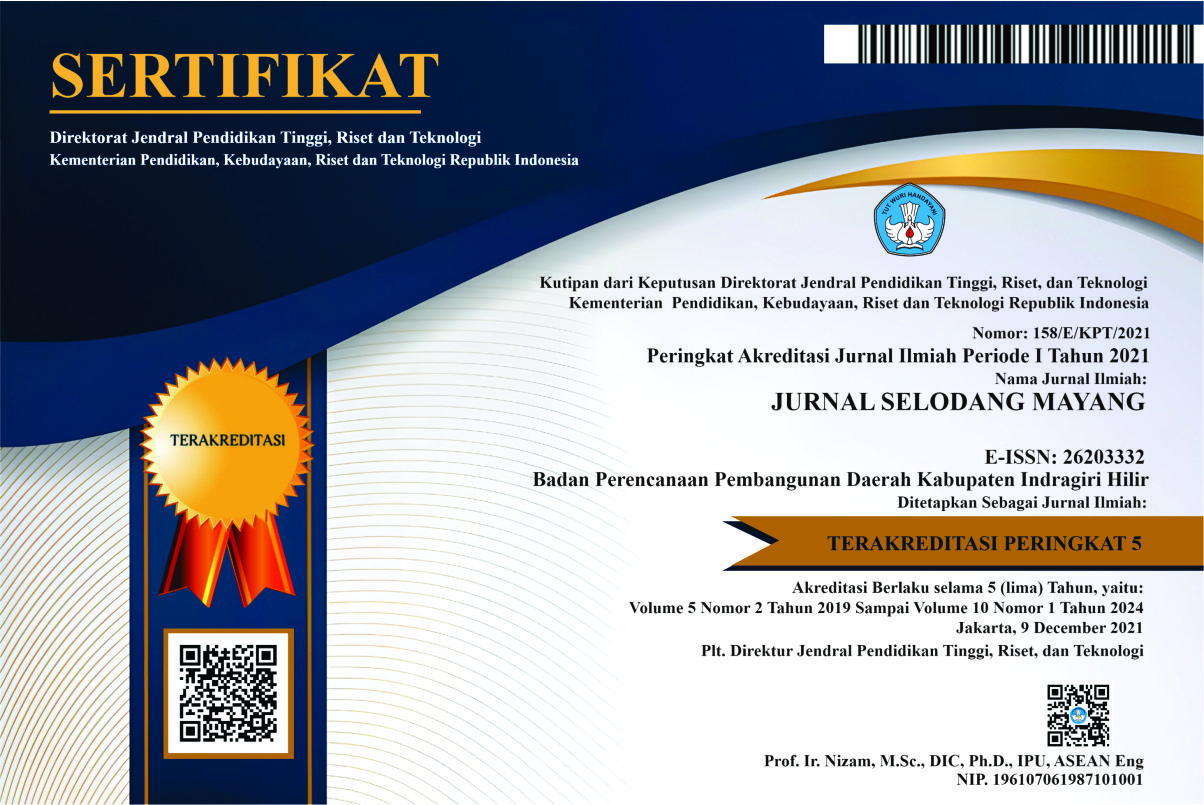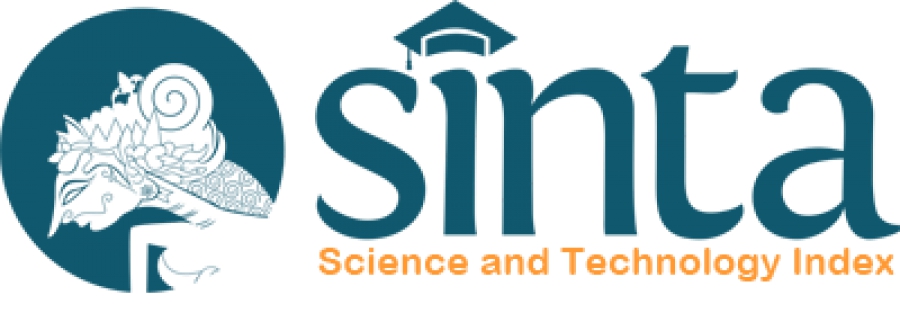PERILAKU PASAR KELAPA TINGKAT PETANI
Abstract
This research aims to analyze the structure, conduct, and performance of the coconut market in the villages of Teluk Dalam, KuIndra Subdistrict. A sampling of farmers using accidental sampling and merchant sampling using the census method. Data analysis descriptively and quantitatively. Descriptively the market structure is seen through the number of market participants and market behavior is seen through the practice of price formation. Quantitatively, market structure analysis uses concentration analysis of market behavior using correlation analysis. The results of this research show Market behavior indicates that factories and traders dominate the market, this is seen from the value of the transmission price <1 are the channels with the lowest margin among the four channels in Teluk Dalam Villages.
Penelitian ini bertujuan untuk menganalisis struktur, perilaku dan kinerja pasar kelapa di desa Teluk Dalam, Kecamatan KuIndra. Pengambilan sampel petani menggunakan accidential sampling dan sampel pedagang menggunakan metode sensus. Analisis data dengan deskriptif dan kuantitatif. Secara deskriptif struktur pasar dilihat melalui jumlah pelaku pasar dan perilaku pasar dilihat melalui praktik pembentukan harga. Secara kuantitatif, analisis struktur pasar menggunakan analisis konsentrasi perilaku pasar dengan menggunakan analisis korelasi. Hasil penelitian ini adalah Perilaku pasar menunjukkan bahwa pabrik dan pedagang mendominasi pasar, hal ini dilihat dari nilai harga transmisi <1 merupakan saluran dengan margin terendah di antara empat saluran di Desa Teluk Dalam.
References
[2] G. S. Gopan and S. Manjunath, “Significance of Marketing Channel choice on value addition and its effectiveness-A study on Coconut Products in Kerala,” Journal of Positive School Psychology, vol. 6, no. 3, 2022.
[3] M. Apriyanto et al., “A SWOT Analysis to Improve The Marketing of Young Coconut Chips,” Annals of the Romanian Society for Cell Biology, vol. 25, no. 4, pp. 13232–13240, 2021.
[4] M. Syaifulloh, S. B. Riono, and S. N. Utami, “Young Coconut Trader Marketing Strategy During the Pandemic,” in Proceedings of the Tegal International Conference on Applied Social Science & Humanities (TICASSH 2022), Paris: Atlantis Press SARL, 2023, pp. 492–500. doi: 10.2991/978-2-494069-09-1_57.
[5] I. G. Phanga, J. K. L. Chanb, T.-Y. Limc, and M. B. R. Fresnido, “Key Success Factors, Marketing Opportunities and Challenges: A Case Study of Bonco Virgin Coconut Oil,” JOURNAL OF AGRIBUSINESS MARKETING, vol. 9, no. 1, 2022.
[6] F. A. Zainol et al., “Coconut Value Chain Analysis: A Systematic Review,” Agriculture, vol. 13, no. 7, p. 1379, Jul. 2023, doi: 10.3390/agriculture13071379.
[7] B. Dharmawan, Suyono, A. Sutanto, I. K. Wijayanti, and D. D. Putri, “Healthy organic coconut sugar powder business’s development strategy: A case study at the Nira Perwira Cooperative, Purbalingga District, Central Java, Indonesia,” IOP Conference Series: Earth and Environmental Science, vol. 1131, no. 1, p. 012008, Jan. 2023, doi: 10.1088/1755-1315/1131/1/012008.
[8] M. Apriyanto, “Latar Belakang Masalah Penelitian,” in Metodologi Penelitian Pertanian, Nuta Media, 2021.
[9] J. Prianto, R. Novitasari, and M. Apriyanto, “Pengaruh Penambahan Daun Pandan Wangi Pada Pengolahan Vco (Virgin Coconut Oil) Terhadap Kesukaan Konsumen,” Selodang Mayang: Jurnal Ilmiah Badan Perencanaan Pembangunan Daerah Kabupaten Indragiri Hilir, vol. 8, no. 1, pp. 66–72, 2022, doi: 10.47521/selodangmayang.v8i1.239.
[10] V. Pragadeesh, S. Sebastian, S. S. B. Bhuvaneswari, and R. G. Selvi, “An Analytical Study on Marketing Behaviour of Coconut Growers in Coimbatore District,” Asian Journal of Agricultural Extension, Economics & Sociology, pp. 945–953, Aug. 2022, doi: 10.9734/ajaees/2022/v40i1031163.
[11] N. Deepa, “Status of Coconut Farmer Producer Companies (CPCs) in Western Tamil Nadu,” Asian Journal of Agricultural Extension, Economics & Sociology, vol. 41, no. 8, pp. 97–102, Jun. 2023, doi: 10.9734/ajaees/2023/v41i81985.
[12] M. Apriyanto, P. Diawati, L. Fangohoi, Elfarisna, F. Azuz, and E. Sutrisno, “Small-scale Coconut Farmers in Indragiri Hilir District as a Model of Youth Entrepreneurship in the Plantation Sector,” in Proceedings of the International Conference on Social, Economics, Business, and Education (ICSEBE 2021), 2022, pp. 69–72. doi: 10.2991/aebmr.k.220107.014.
[13] M. Marlina, M. Apriyanto, R. Novitasari, K. Novyar Satriawan Fikri, and W. Widyawati, “ENTREPRENEURSHIP PERKEBUNAN KELAPA DI KABUPATEN INDRAGIRI HILIR,” Selodang Mayang: Jurnal Ilmiah Badan Perencanaan Pembangunan Daerah Kabupaten Indragiri Hilir, vol. 8, no. 1, pp. 1–5, Apr. 2022, doi: 10.47521/selodangmayang.v8i1.235.
[14] R. W. A. Hutami, S. M. I. Z. Maaruf, M. Ramli, and M. Apriyanto, “Independent Palm Oil Small Holders’ Plans Regarding Their Behaviour,” Tropical Plantation Journal, vol. 2, no. 2, pp. 14–21, Jun. 2023, doi: 10.56125/tpj.v2i2.22.
[15] N. D. Samsul Aripin*, Jum’atri Yusri**, “ANALISIS STRUKTUR, PERILAKU DAN PENAMPILAN PASAR KELAPA DI KECAMATAN KATEMAN KABUPATEN INDRAGIRI HILIR (STUDI KASUS DESA SARI MULYA DAN DESA PENJURU),” Indonesian Journal of Agricultural Economics (IJAE), vol. 12, no. 1, p. 6, 2021.
[16] C. Worku, M. Mengistu, and S. Bezie, “Market chain analysis of chickpea in Northwest Ethiopia,” Legume Science, vol. 5, no. 4, Dec. 2023, doi: 10.1002/leg3.191.
[17] Safiya Iskandarovna Muminova, Bulan Prabawani, and Andi Wijayanto, “Innovative strategies for the development of business model canvas in coconut charcoal export companies: A case study of Yogyakarta,” World Journal of Advanced Research and Reviews, vol. 18, no. 3, pp. 127–139, Jun. 2023, doi: 10.30574/wjarr.2023.18.3.1025.
[18] A. N. Kairupan et al., “Value Chain Implementation in Rural-Scale Integrated Coconut Farming System in North Sulawesi Province, Indonesia,” in Agricultural Value Chains, intechopen.com, 2023. doi: 10.5772/intechopen.110190.
[19] L. Sondak, D. Hadi Darwanto, and L. Rahayu Waluyati, “Partnership Pattern of Desiccated Coconut Value Chain in North Sulawesi,” E3S Web of Conferences, vol. 444, p. 02021, Nov. 2023, doi: 10.1051/e3sconf/202344402021.
Copyright (c) 2024 Selodang Mayang: Jurnal Ilmiah Badan Perencanaan Pembangunan Daerah Kabupaten Indragiri Hilir

This work is licensed under a Creative Commons Attribution-ShareAlike 4.0 International License.










